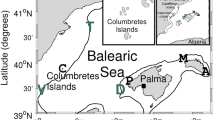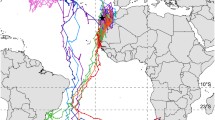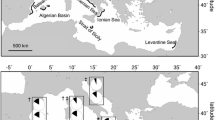Abstract
Long-distance migration is a major part of the life cycle of many seabirds. The main processes driving local movements within those long-distance migratory movements are essentially unknown. Here, we studied detailed patterns of the movements with respect to distance from land of the most abundant seabird species migrating across the northernmost part of the Strait of Gibraltar and analysed how ocean surface winds influence those patterns. We did this by using visual and S-band radar surveys. Our results show that seabirds followed lines of travel that were located nearer the coast than randomly expected. Re-sampling techniques and comparison with additional data from ship-based counts corroborated this pattern, which was not substantially affected by the decrease in detection at distances of up to 3,000 m. Wind direction and speed covaried with local patterns of flight trajectories in a general manner. All the seabirds responded to headwinds by approaching the coast in proportion to the magnitude of wind intensity. Such a change in flight patterns could be a strategy to reduce the effect of headwinds, by approaching the coast where wind intensity was reduced by orographic factors. Under tailwind conditions, seabirds tended to fly further from the coast, profiting from increasing winds further from shore. Our results imply that modification of off-shore distance in relation to conditions of ocean surface winds may be an energetically advantageous strategy for migrating seabirds. Off-shore distances were also dependent on global and local migratory behaviour of different species, but not on flight type.




Similar content being viewed by others
References
Abelló P, Arcos JM, Gil de Sola L (2003) Geographical patterns of seabirds attendance to a research trawler along the Iberian Mediterranean coast. Sci Mar 67:69–75
Adams J, Flora S (2010) Correlating seabirds movements with ocean winds: linking satellite telemetry with ocean scatterometry. Mar Biol 157:915–929
Alerstam T (1976) Bird migration in relation to wind and topography. PhD thesis, University of Lund, Sweden
Alerstam T, Gudmundsson GA, Larsson B (1993) Flight tracks and speeds of Antarctic and Atlantic seabirds: radar and optical instruments. Philos Trans R Soc Lond B 340:55–67
Apel JR (1988) Principles of ocean physics. Academic Press, London
Arcos JM (2001) Foraging ecology of seabirds at sea: significance of commercial fisheries in the NW Mediterranean. PhD thesis, University of Barcelona, Spain
Bruderer B, Steuri T, Baumgartner M (1995) Short-range high-precision surveillance of nocturnal migration and tracking of single targets. Isr J Zool 41:207–220
Buckland ST, Anderson DR, Burnham KP, Laake JL, Borchers DL, Thomas L (2001) Introduction to distance sampling. Estimating abundance of biological populations. Oxford University Press, Oxford
Burnham KP, Anderson DR (2002) Model selection and multimodel inference. A practical information-theoretic approach. Springer, New York
Christensen T, Hounisen JP, Clausager I, Petersen IK (2003) Visual and radar observations of birds in relation to collision risk at the Horns Rev offshore wind farm. Annual status report. National Environmental Research Institute, Denmark
Cramp S, Simmons KEL (1977) The birds of the Western Palearctic. Vol. I: Ostrich to ducks. Oxford University Press, Oxford
Cramp S, Simmons KEL (1980) The birds of the Western Palearctic. Vol. II: Hawks to bustards. Oxford University Press, Oxford
Desholm M (2003) How much do small-scale changes in flight direction increase overall migration distance? J Avian Biol 34:155–158
Desholm M, Fox AD, Beasley P, Kahlert J (2006) Remote techniques for counting and estimating the number of bird-wind turbine collisions at sea: a review. Ibis 148:76–89
Erni B, Liechti F, Bruderer B (2005) The role of wind in passerine autumn migration between Europe and Africa. Behav Ecol 16:732–740
Felicísimo AM, Muñoz J, González-Solís J (2008) Ocean surface winds drive dynamics of transoceanic aerial movements. PLoS One 3:1–7
González-Solís J, Croxall JP, Oro D, Ruiz X (2007) Transequatorial migration and mixing in the wintering areas in a pelagic seabird. Front Ecol Environ 5:297–301
González-Solís J, Felicísimo AM, Fox JW, Afanasyev V, Kolbeinsson Y, Muñoz J (2009) Influence of sea surface wind son shearwater migration detours. Mar Ecol Prog Ser 391:221–230
Good P (2006) Resampling methods: a practical guide to data analyses, 3rd edn. Birkhäuser, Boston
Greene DF, Quesada M, Calogeropoulos C (2008) Dispersal of seeds by the tropical sea breeze. Ecology 89:118–125
Gregory PH (1973) The microbiology of the atmosphere, 2nd edn. Leonard Hill, Aylesbury
Gudmundsson GA, Alerstam T, Larsson B (1992) Radar observations of northbound migration of the Arctic Tern Sterna paradisaea, at the Antarctic Peninsula. Antarct Sci 4:163–170
Hashmi D (2000) Opportunities for Monitoring Seabirds and Cetaceans in the Strait of Gibraltar. In: Proceedings of the 5th Medmaravis symposium. Gozo, Malta, pp 176–191
Hastie T, Tibshirani RJ (1990) Generalized additive models. Chapman & Hall, London
Jiménez J, Navarrete J (2001) Estatus y fenología de las aves en Ceuta. Instituto de Estudios Ceutíes
Liechti F, Klaassen M, Bruderer B (2000) Predicting migratory flight altitudes by physiological migration models. Auk 117:205–214
Manly BFJ (2001) Randomization, bootstrap and Monte Carlo methods in biology, 2nd edn. Chapman and Hall/CRC, Florida
Marques FFC, Buckland ST (2004) Covariate models for the detection function. In: Buckland ST, Anderson DR, Burnham KP, Laake JK, Borschers DL, Thomas L (eds) Advanced distance sampling. Oxford University Press, Oxford, pp 31–47
Marques FFC, Thomas L, Fancy SG, Buckland ST (2007) Improving estimates of bird density using multiple covariate distance sampling. Auk 124:1229–1243
Mateos M (2007) Patrones de atracción de las aves marinas a un arrastrero de investigación en el golfo de Cádiz, España. Trabajo para la evaluación del periodo de investigación. University of Cadiz, Spain
Mateos M (2009) Radar technology applied to the study of seabird migration across the Strait of Gibraltar. PhD thesis, University of Cadiz, Spain
Mateos M, Arroyo GM, Rodríguez A, Cuenca D, de la Cruz A (2010) Calibration of visually estimated distances to migrating seabirds with radar measurements. J Field Ornithol 81(3):302–309. doi:10.1111/j.1557-9263.2010.00286.x
Medina F, Galván M (2007) Imputación de datos: teoría y práctica. Naciones Unidas, División de Estadística y proyecciones económicas. Serie estudios estadísticos y prospectivos, vol 54. Santiago de Chile
Meseguer J, Álvarez JC, Pérez A (2004) Formas de retrasar la entrada en pérdidas en las alas de las aves. Instituto Universitario de Microgravedad “Ignacio Da Riva”, Universidad Politécnica de Madrid. IDR/PA 0104
Murray MD, Nicholls DG, Butcher E, Moors PJ, Walker K et al (2003) How Wandering Albatrosses use weather systems to fly long distances. 3. The contributions of Antarctic LOWS to eastward, southward and northward flight. Emu 103:111–120
Navarrete J (2008) Post-breeding migration of Cory’s shearwater Calonectris diomedea in Ceuta coastal waters. Boletin GIAM 31:2–6
Paterson AM (1997) Las aves marinas de España y Portugal. Lynx Edicions, Barcelona
Pennycuick CJ (1987) Flight of Auks (Alcidae) and other northern seabirds compared with southern Procellariiformes: Ornithodolite observations. J Exp Biol 128:335–347
Pennycuick CJ (1989) Bird flight performance: a practical calculation manual. Oxford University Press, Oxford
Programa Migres (2009) Seguimiento de la migración de las aves en el Estrecho de Gibraltar: resultados del Programa Migres 2008. Migres, revista de ecología 1:83–101
R Development Core Team (2008) R: a language and environment for statistical computing. R Foundation for Statistical Computing, Vienna
Ritchie SA, Rochester WA (2001) Wind-blown mosquitoes and introduction of Japanese encephalitis into Australia. Emerg Infect Dis 7:900–903
Schmaljohann H, Liechti F, Bächler E, Steuri T, Bruderer B (2008) Quantification of bird migration by radar—a detection probability problem. Ibis 150(2):342–355
Spear LB, Ainley DG (1997) Flight speed of seabirds in relation to wind speed and direction. Ibis 139:234–251
Tasker ML, Hope-Jones P, Dixon T, Blake BF (1984) Counting seabirds at sea from ships: a review of methods employed and a suggestion for a standardized approach. Auk 101:567–577
Taylor SV, Cayan DR, Graham NE, Georgakakos KP (2008) Northerly surface winds over the eastern North Pacific Ocean in spring and summer. J Geophys Res 113:D02110. doi:10.1029/2006JD008053
Thomas L, Laake JL, Strindberg S, Marques FFC, Buckland ST, Borchers DL, Anderson DR, Burnham KP, Hedley SL, Pollard JH, Bishop JRB, Marques TA (2006) Distance 5.0. Release 2. Research Unit for Wildlife Population Assessment, University of St. Andrews, UK. http://www.ruwpa.st-and.ac.uk/distance
Warham J (1977) Wing loadings, wing shapes, and flight capabilities of Procellariiformes. N Z J Zool 4:73–83
Acknowledgments
This study was conducted within a collaboration agreement between the Migres Foundation and the University of Cádiz. The radar facilities were supplied by Ceowind Capital Energy Off-shore Company. María Mateos was granted with an FPU fellowship by the Junta de Andalucía. We thank Migres Foundation technical staff for their help in the fieldwork and Dr. Bruno Bruderer, Dr. Mark Desholm, Dr. Jacob González-Solís, Andy Paterson and two anonymous referees for their comments and suggestions on previous versions of this manuscript.
Author information
Authors and Affiliations
Corresponding author
Additional information
Communicated by M. E. Hauber.
Appendix: Ship transects surveys across the Strait of Gibraltar
Appendix: Ship transects surveys across the Strait of Gibraltar
From 2002 to 2006, within the project “Migres Marinas”, staff from the University of Cádiz and the Migres Foundation carried out ship transects across the Strait of Gibraltar from commercial ferries covering the line Algeciras–Tangier (unpublished data; Fig. 5). In all these surveys, the strip transects technique described by Tasker et al. (1984) was used. This method consists of continuous counts along the transect line, where all birds detected within a pre-set perpendicular distance (the strip width is 300 m to both sides of the line, 600 m in total) are recorded. Continuous counts were subdivided into 10-min sequences, with ship position being recorder at the beginning, the middle and the end of each sequence.
Sketch of the Strait of Gibraltar with the commercial ferry route between Algeciras and Tangier from which strip transects were carried out (the northern route is the one that the ferry follows in the transect Algeciras to Tangier; the southern one is that from Tangier to Algeciras). From all the positions measured at the beginning, at the end and in the middle of each observation sequence, we were able to map the mean trajectory (broken line) and the limits of 90% variation around the line (dotted line). The transect piece is shown as a black line. The number of spotted birds at each latitudinal location of the ship was transformed into distance from our reference point at Tarifa Island (along the N–S line from Tarifa towards Africa). A small line shows where the 3,000 m distance from Tarifa is located, at which data for further analysis were truncated
For the purpose of comparing seabird distribution during autumn migration obtained from land counts and from ship transects, trips carried out in the months of October and November from 2002 to 2006 from Algeciras to Tangier were selected, constituting a total of 14 trips. Transect’s zones with an N–S direction were eliminated. The transect starting at the northernmost point of the NE–SW transect and stopping at Tarifa longitude was used (Fig. 5). The number of spotted birds during each 10-min sequence was pooled, and the geographic position measured in the middle of the corresponding sequence was taken as the position of this group of birds. The latitudes derived from the ship transects were transformed into distances south of the Tarifa reference point. To do it, the latitude at the transect’s northernmost point was consider as distance cero from Tarifa and the distance at Tarifa longitude as it correspondent distance to Tarifa coast (Fig. 5) and apply the follow equation:
In this way, position from coast on ferry route was translated into distance from bird observation station. Distances obtained were pooled into distance intervals of 500 m and were truncated at 3,000 m. This conversion could be done, because field evidence shows that the majority of seabirds maintain an east–west direction (either E–W or W–E) when crossing the Strait, thus crossing the NE–SW part of the ferry transect at an angle of about 10–20°. The vast majority of the tracks recorded in the Tarifa Island by the radar followed the same E–W or W–E direction (Mateos 2009). Also, the birds/flocks visually observed from the Tarifa Island throughout the Migres Marinas program followed E–W directions. There are no indications of birds maintaining their off-shore distances and following the NE–SW direction of the coastline to the E of Tarifa. Obviously, birds/flocks approaching the reference point from E or W while flying further north than the latitude of the Isla de Tarifa have to redirect their flight course slightly southward to avoid flights across land. Our suspicion is that they use the Tarifa island as a geographical reference point, while taking up their previous E–W or W–E course after passage.
For the comparison of land-bound observations and ship transects, we included the total number of birds spotted within each interval both from land and from ship, standardising the numbers with the available observation time per distance interval. The number of birds per interval, standardised by the observation time in that interval and given as a percentage of the standardised total within the N–S distance of 3,000 m from the reference point were compared between land and ship surveys by using χ 2 test.
To determine whether the probability to detect birds further away from Tarifa decreases with increasing wind in the Strait of Gibraltar, by using Distance Sampling procedure (as explained in “Methods” section) all ship transects were used, both those form Algeciras to Tangier and from Tangier to Algeciras during the whole year (46 trips from Algeciras to Tangier and 46 from Tangier to Algeciras).
Rights and permissions
About this article
Cite this article
Mateos, M., Arroyo, G.M. Ocean surface winds drive local-scale movements within long-distance migrations of seabirds. Mar Biol 158, 329–339 (2011). https://doi.org/10.1007/s00227-010-1561-y
Received:
Accepted:
Published:
Issue Date:
DOI: https://doi.org/10.1007/s00227-010-1561-y





